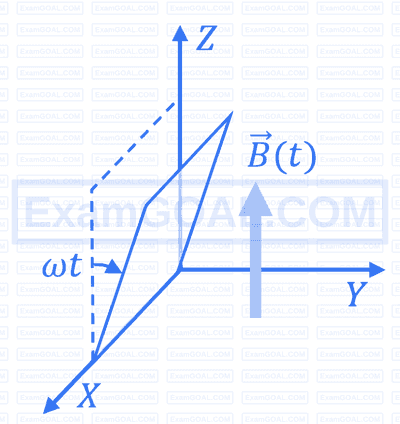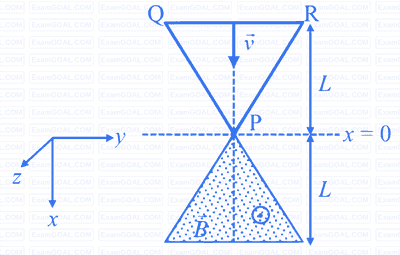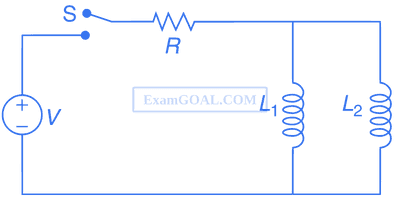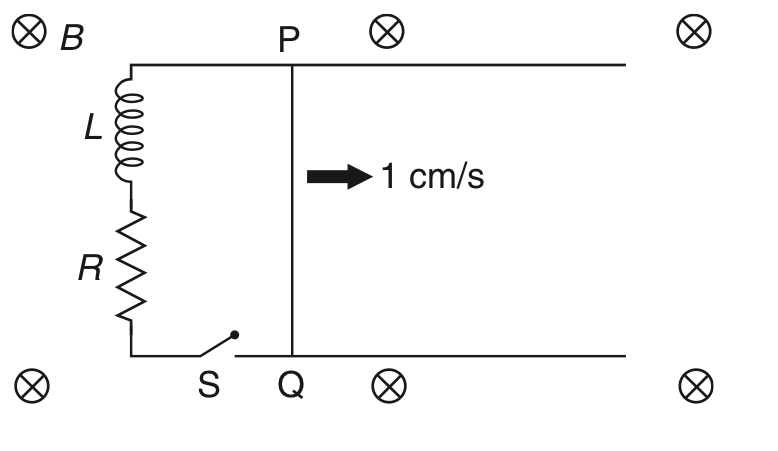Electromagnetic Induction · Physics · JEE Advanced
MCQ (Single Correct Answer)
A conducting square loop initially lies in the $X Z$ plane with its lower edge hinged along the $X$-axis. Only in the region $y \geq 0$, there is a time dependent magnetic field pointing along the $Z$-direction, $\vec{B}(t)=B_0(\cos \omega t) \hat{k}$, where $B_0$ is a constant. The magnetic field is zero everywhere else. At time $t=0$, the loop starts rotating with constant angular speed $\omega$ about the $X$ axis in the clockwise direction as viewed from the $+X$ axis (as shown in the figure). Ignoring self-inductance of the loop and gravity, which of the following plots correctly represents the induced e.m.f. $(V)$ in the loop as a function of time:

A region in the form of an equilateral triangle (in $x-y$ plane) of height $L$ has a uniform magnetic field $\vec{B}$ pointing in the $+z$-direction. A conducting loop $\mathrm{PQR}$, in the form of an equilateral triangle of the same height $L$, is placed in the $x-y$ plane with its vertex $\mathrm{P}$ at $x=0$ in the orientation shown in the figure. At $t=0$, the loop starts entering the region of the magnetic field with a uniform velocity $\vec{v}$ along the $+x$-direction. The plane of the loop and its orientation remain unchanged throughout its motion.

Which of the following graph best depicts the variation of the induced emf $(E)$ in the loop as a function of the distance $(x)$ starting from $x=0$ ?
[Given: The acceleration due to gravity $g=10 \mathrm{~m} \mathrm{~s}^{-2}$ and $e^{-1}=0.4$ ]

| List - I | List - II |
|---|---|
| (P) At $t=0.2 \mathrm{~s}$, the magnitude of the induced emf in Volt | (1) 0.07 |
| (Q) At $t=0.2 \mathrm{~s}$, the magnitude of the magnetic force in Newton | (2) 0.14 |
| (R) At $t=0.2 \mathrm{~s}$, the power dissipated as heat in Watt | (3) 1.20 |
| (S) The magnitude of terminal velocity of the rod in $\mathrm{m} \mathrm{s}^{-1}$ | (4) 0.12 |
| (5) 2.00 |
The figure shows certain wire segments joined together to form a coplanar loop. The loop is placed in a perpendicular magnetic field in the direction going into the plane of the figure. The magnitude of the field increases with time. $$I_1$$ and $$I_2$$ are the currents in the segments ab and cd. Then,

MCQ (More than One Correct Answer)
A conducting square loop of side $L$, mass $M$ and resistance $R$ is moving in the $X Y$ plane with its edges parallel to the $X$ and $Y$ axes. The region $y \geq 0$ has a uniform magnetic field, $\vec{B}=B_0 \widehat{k}$. The magnetic field is zero everywhere else. At time $t=0$, the loop starts to enter the magnetic field with an initial velocity $v_0 \hat{\jmath} \mathrm{~m} / \mathrm{s}$, as shown in the figure. Considering the quantity $K=\frac{B_0^2 L^2}{R M}$ in appropriate units, ignoring self-inductance of the loop and gravity, which of the following statements is/are correct:




Which of the following options is/are correct?


Which of the following schematic plot(s) is (are) correct? (Ignore gravity)

A current carrying infinitely long wire is kept along the diameter of a circular wire loop, without touching it, the correct statement(s) is(are)
Two metallic rings A and B, identical in shape and size but having different resistivities $$\rho_A$$ and $$\rho_B$$, are kept on top of two identical solenoids as shown in the figure below. When current I is switched on in both the solenoids in identical manner, the rings A and B jump to heights $$h_A$$ and $$h_B$$, respectively, with $$h_A > h_B$$. The possible relation(s) between their resistivities and their masses $$m_A$$ and $$m_B$$ is (are)

Numerical

[Assume the velocity of wire PQ remains constant (1 cm/s) after key S is closed. Given e-1 = 0.37, where e is base of the natural logarithm]

A circular wire loop of radius R is placed in the xy plane centred at the origin O. A square loop of side a(a << R) having two turns is placed with its centre at z = $$\sqrt3$$R along the axis of the circular wire loop, as shown in the figure. The plane of the square loop makes an angle of 45$$^\circ$$ with respect to z-axis. If the mutual inductance between the loops is given by $${{{\mu _0}{a^2}} \over {{2^{p/2}}R}}$$, then the value of p is ___________.
